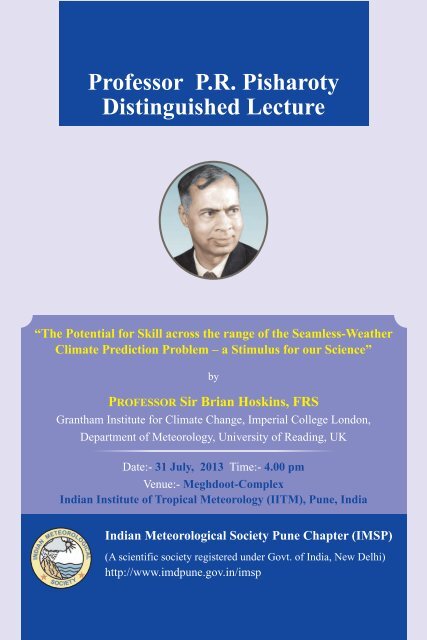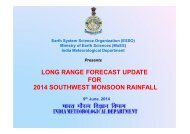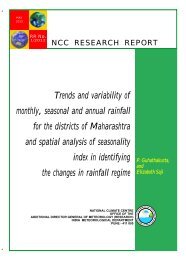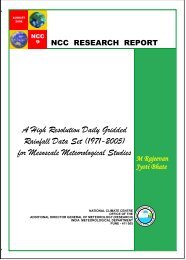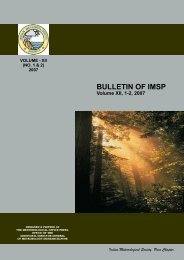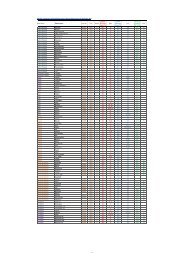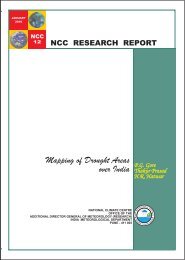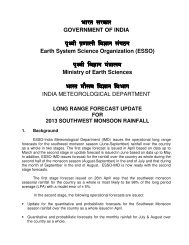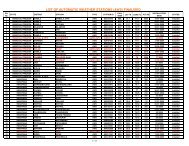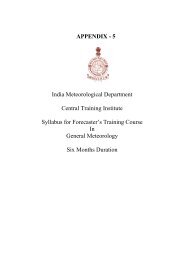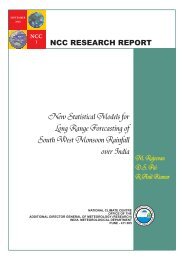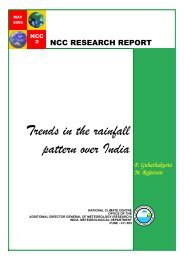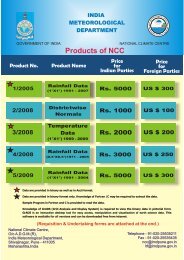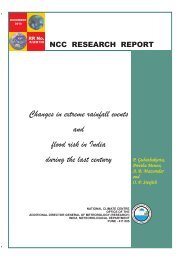Professor P.R. Pisharoty Distinguished Lecture - (IMD), Pune
Professor P.R. Pisharoty Distinguished Lecture - (IMD), Pune
Professor P.R. Pisharoty Distinguished Lecture - (IMD), Pune
Create successful ePaper yourself
Turn your PDF publications into a flip-book with our unique Google optimized e-Paper software.
<strong>Professor</strong> P.R. <strong>Pisharoty</strong><strong>Distinguished</strong> <strong>Lecture</strong>“The Potential for Skill across the range of the Seamless-WeatherClimate Prediction Problem – a Stimulus for our Science”byPROFESSOR Sir Brian Hoskins, FRSGrantham Institute for Climate Change, Imperial College London,Department of Meteorology, University of Reading, UKDate:- 31 July, 2013 Time:- 4.00 pmVenue:- Meghdoot-ComplexIndian Institute of Tropical Meteorology (IITM), <strong>Pune</strong>, IndiaIndian Meteorological Society <strong>Pune</strong> Chapter ( IMSP)(A scientific society registered under Govt. of India, New Delhi)http://www.imdpune.gov.in/imsp
<strong>Professor</strong> Pisharoth Rama <strong>Pisharoty</strong> - the father of theIndian Remote Sensing Programme, a distinguished meteorologistand a space scientist of international repute was born onth10 February 1909 at Kollengode, Palghat District, Kerala.Starting with his early education in Kerala, Prof. <strong>Pisharoty</strong> had abrilliant academic career in Trichinopoly and Chennai (MadrasState), Bangalore and Los Angeles, and worked with the NobelLaureate Sir C.V. Raman, at the Indian Institute of Science,Bangalore. He began his professional career as a <strong>Lecture</strong>r inLoyola College, Chennai in 1935 and later joined as a SeniorOfficer in the India Meteorological Services in 1942, where heconducted research on thunderstorms, western disturbances,monsoon depressions, orographic rain etc. Prof. <strong>Pisharoty</strong> thenjoined the University of California where he came in close contactwith world renowned meteorologists like <strong>Professor</strong>s JacobBjerkenes, Holmboe, Jule Charney, Neilburger, Yale Mintz andWurtele. During this time, he was engaged in investigations ofatmospheric general circulation and published two reports entitled“Some aspects of geostrophic poleward flux of sensible heat” and“The kinetic energy of the atmosphere”. After obtaining his MS andPhD degrees in 1954, he returned to India.Prof. <strong>Pisharoty</strong> was the Director of the ColabaObservatory, Mumbai (Bombay) during 1959-1962 and alsodirected the International Indian Ocean Expedition (IIOE)programme (1961-62). He became the Founder Director of theInstitute of Tropical Meteorology, <strong>Pune</strong> (now known as the IndianInstitute of Tropical Meteorology, IITM) in 1962 and wasinstrumental in nurturing the Institute in its initial formative years.
Following his retirement from IITM in February 1967,Prof. <strong>Pisharoty</strong> was invited by Prof. K.R. Ramanathan andDr. Vikram Sarabhai as a senior professor of Aeronomy at thePhysical Research Laboratory (PRL), Ahmedabad. At this point,he was instrumental in introducing remote sensing technology toIndia. His pioneering experiment of detection of coconut wiltrootdisease using Soviet aircraft and US equipment wasconsidered to be the first success in remote sensing in IndiaProf. <strong>Pisharoty</strong> served as the Director, Remote Sensingand Satellite Meteorology, at the ISRO Space ApplicationsCentre, Ahmedabad during 1972-75. He was a Member of theScientific Advisory Board of World MeteorologicalOrganization from 1963 to 1968 and later its Chairman. He alsoserved as the Vice-President of the International Association ofMeteorology and Atmospheric Sciences, and as a ExecutiveMember of the Joint Organising Committee for GlobalAtmospheric Research Programme from 1969 to 1977. Heworked at the PRL until the early nineties when he retired forhealth reasons. Prof. <strong>Pisharoty</strong> contributed to a good number ofresearch papers in national and international journals and wrote anumber of books on the Indian Monsoon and related topicsProf. <strong>Pisharoty</strong> was elected a Fellow of the IndianAcademy of Sciences in 1957 and a Fellow of the IndianNational Science Academy in 1978. In recognition of hiscontributions, he was awarded the prestigious Padma Shrinational civilian award of the Indian government in 1970.He was the first recipient of the Raman Centenary Medal in1988. He was awarded the IMO Prize by the WMO in 1989.He was also conferred the K.R. Ramanathan Medalestablished by the Indian National Science Academy in1990. He died on the morning of September 24, 2002 at<strong>Pune</strong>, at the age of 93. Prof. <strong>Pisharoty</strong> continues to remainas a major inspiration for many young meteorologists andwill be fondly remembered for his inimitable style ofinaugurating scientific meetings, seminars and symposiawith invocation of Sanskrit verses and explaining theirmeaning very carefully.
<strong>Professor</strong> Sir Brian Hoskins was born on 17 May 1945 inBristol, England. He did his secondary education at BristolGrammar School. He then went to Cambridge to studyMathematics, his College being Trinity Hall. In 1966, he obtained afirst class degree and followed this with a Distinction in Part 3Mathematics. From 1967-70, he did his PhD in Mathematics atCambridge, the topic being the mathematical theory offrontogenesis. For the third year of his PhD he moved with hissupervisor Francis Bretherton to Johns Hopkins University in theUSA.After his PhD he went for a post-doc year at the NationalCenter for Atmospheric Research in Boulder, Colorado. He thenreturned to the UK to a new atmospheric modelling group in theUniversity of Reading under the leadership of Robert Pearce. In1972 he went GFDL, Princeton and the next year he returned toReading, taking up the leadership of the atmospheric modellinggroup. He has been at the Department of Meteorology since then,becoming a Reader in 1976, <strong>Professor</strong> in 1981 and was Head ofDepartment 1990-96. He held a short-term Visiting <strong>Professor</strong>shipin the Isaac Newton Institute in Cambridge in 1996 and a RoyalSociety <strong>Professor</strong>ship 2000-2010. In 2008 he became the firstDirector of the Grantham Institute for Climate Change at ImperialCollege London, dividing his time between there and Reading.
In his PhD thesis, he produced the basic theory on 'whyfronts form'. From there the focus for his scientific research spreadto a wide range of atmospheric phenomena on all scales. Among hisother achievements is the basic understanding of how large-scalewaves propagate around the world, producing teleconnectionsbetween different regions. He was a pioneer in the spectraltechnique for numerical modelling of the atmosphere. Using suchmodels for idealised experiments, he greatly extended the theory ofmid-latitude weather systems. He has produced fundamentalunderstanding of summer monsoons and subtropical high pressuresystems. He has played a vital role in the development of moderndynamical meteorology, and in particular, he pioneered the use ofpotential vorticity variable. He has published 175 papers in peerreviewed journals and edited 4 books.He has been awarded a number of Prizes by the RoyalMeteorological Society, including its Symons Gold Medal. In1988, he received the Carl-Gustav Rossby Research Medal of theAmerican Meteorological Society and in 1997, the VilhelmBjerknes Medal of the European Geophysical Society. He becamea Fellow of the Royal Society in 1988, a member of the AcademiaEuropaea in 1990 and the Barcelona Academy in 1993, and in2002, he became a Foreign Associate of the National Academy ofScience and a Foreign Member of the Chinese Academy ofSciences. He has honorary degrees from the University of Bristoland East Anglia. He has given many named lectures, and in 2011,thgave the 12 IMO <strong>Lecture</strong> to the quadrennial meeting of the WorldMeteorological Organisation. In 1998, he was made a Commanderof the British Empire for Service to Meteorology, and in 2007 hewas knighted for Services to Environmental Sciences.
His international activities have included being Presidentof the International Association of Meteorology and AtmosphericSciences and Vice-Chair of the Joint Scientific Committee of theWorld Climate Research Programme. His Scientific AdvisoryCommittee roles have included those for The European Centre forMedium Range Weather Forecasts, the Max Planck in Hamburg,the Potsdam Institute for Climate Impact Research and a laboratoryof the Chinese Academy. He was recently the External Expert onthe Review of the Max Planck Society Earth Science Institutes.He was a Review Editor and Summary writer for the '2007 IPCCWorking Group 1 Report'.He has held a number of positions in the UK. He has been aCouncil Member of the Natural Environment Research Council, amember of the Royal Society Council, a Non-Executive Director ofthe Met Office and Chairman of its Scientific Advisory Committee,and President of the Royal Meteorological Society. In 1990, he wasSpecial Advisor to the UK Secretary of State for Transport. For7 years he was a member of the Royal Commission forEnvironmental Pollution, and played a large role in its report thatwas the first to quantify a UK carbon dioxide reduction target. He isnow a member of the UK Climate Change Committee whichadvises the UK Government on Greenhouse gas reduction targetsand reports to Parliament on progress on achieving them. He hasgiven many public lectures, interviews for radio, television and thepress, and briefings for politicians.His recreational activities include sport, music andgardening. He was captain of cricket and hockey in both his schooland college, and played count hockey. He plays the piano and singsin a choir, and grows many of his own vegetables.
AbstractAbstract“The Potential for Skill across the range of the Seamless-WeatherClimate Prediction Problem – a Stimulus for our Science”Brian HoskinsGrantham Institute for Climate Change, Imperial College London,Department of Meteorology, University of Reading, UKPredictability is considered in the context of the seamlessweather-climate prediction problem, and the notion that there can bepredictive power on all time-scales is developed. On all scales there arephenomena that occur as well as longer time-scale and external conditionsthat should combine to give some predictability. To what extent thistheoretical predictability may actually be realised and, further, to what extentit may be useful is not clear. However the potential should provide a stimulusto, and high profile for, our science and its application for many years.
INDIAN METEOROLOGICAL SOCIETYPUNE CHAPTERExecutive Council : 2011-2013Chairman : Shri S. KrishnaiahSecretary : Shri Sikandar M. JamadarJt. Secretary : Dr. Hemantkumar S. ChaudhariTreasurer : Shri Jyotiram P. SapateMembers : Shri Kiran SalunkeDr. Kaustav ChakravartyShri Ashok KhutwadEx-Officio : Dr. Milind MujumdarMembers Dr. Arvind Kumar SrivastavaContact : Web: www.imdpune.gov.in/imspEmail : pune_ims@rediffmail.comsmjamadar@gmail.comSPONSORED BYIndian Institute of Tropical Meteorology(An Autonomous Institute of the Ministry of Earth Sciences, Govt. of India)Dr. Homi Bhabha Road, Pashan, <strong>Pune</strong> 411 008Maharashtra, INDIAPhone: +91-20-2590-4200; Fax : +91-20-2586-5142Website : www.tropmet.res.in


